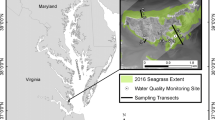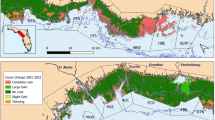Abstract
Beginning in late 1987 Florida Bay experienced a large and unprecedented die-off ofThalassia testudinum. The die-off occurred only in stands of denseT. testudinum. We initiated an experimental monitoring effort in 1989 to attempt to ascertain the cause of this die-off phenomenon. From 1989 to 1995 the abundance and productivity ofT. testudinum was measured at five stations associated with the seagrass die-off and three stations where no die-off had occurred (including one on the seaside of Key Largo, outside of Florida Bay). Early in the study the salinity was very high, exceeding 46 psu, but it has decreased to 29–38 psu in recent years. Seagrass standing crop and either short-shoot density or mass per short shoot declined at nearly all stations, including the stations without die-off (unaffected stations). Over the course of the study, areal productivity declined at three die-off stations; but mass-specific productivity increased at all die-off stations and one unaffected station. Seasonality was pronounced; detrended standardized residuals showed responses for all of the seagrass parameters to be greater than the yearly mean in spring and summer and less than the mean in fall and winter. Detrended residuals also showed decreased productivity to be correlated with increased salinities in the summer despite a long-term record of declining salinities. We propose a conceptual model of the seagrass die-off phenomenon. We document that salinity does contribute to stress onT. testudinum in Florida Bay, but salinity is believed to be only one contributing factor to the loss of seagrasses. The documented increase in the mass-specific productivity ofT. testudinum over the period 1989–1995 suggests seagrasses are growing rapidly in Florida Bay by 1995; we predict that the loss ofT. testudinum may be slowing down and that recovery is possible.
Similar content being viewed by others
Literature Cited
Boyer, J. N., J. W. Fourqurean, andR. D. Jones. 1999. Seasonal and long-term trends in the water quality of Florida Bay (1989–1997).Estuaries 22:417–430.
Cambridge, M. L. andA. J. McComb. 1984. The loss of seagrass in Cockburn Sound, Western Australia. I. The time course and magnitude of the decline in relation to industrial development.Aquatic Botany 20:229–243.
Carlson, P. R., L. A. Yarbro, andT. A. Barber. 1994. Relationship of sediment sulfide to mortality ofThalassia testudinum in Florida Bay.Bulletin of Marine Science 54:733–746.
Czerny, A. B. andK. H. Dunton. 1995. The effects of in situ light reduction on the growth of two subtropical seagrasses,Thalassia testudinum andHalodule wrightii.Estuaries 18:418–427.
Duarte, C. M. 1991. Seagrass depth limits.Aquatic Botany 40: 363–377.
Durako, M. J. 1994. Seagrass die-off in Florida Bay (USA): Changes in shoot demographic characteristics and population dynamics inThalassia testudinum.Marine Ecology—Progress Series 110:59–66.
Durako, M. J. andK. M. Kuss. 1994. Effects ofLabyrinthula infection on the photosynthetic capacity ofThalassia testudinum.Bulletin of Marine Science 54:727–732.
Finucane, J. H. andA. Dragovich. 1959. Counts of red tide organisms,Gymnodinium breve, and associated oceanographic data from the Florida west coast, 1954–1957. United States Fish and Wildlife Service, Special Science Report, Fisheries, No. 298:1–220.
Fourqurean, J. W., R. D. Jones andJ. C. Zieman. 1993. Processes influencing water column nutrient characteristics and phosphorus limitation of phytoplankton biomass in Florida Bay, FL, USA: Inferences from spatial distributions.Estuarin, Coastal and Shelf Science 36:295–314.
Fourqurean, J. W., G. V. N. Powell, andJ. C. Zieman. 1992. Phosphorus limitation of primary production in Florida Bay: Evidence from the C:N:P ratios of the dominant seagrassThalassia testudinum.Limnology and Oceanography 37:162–171.
Fourqurean, J. W. andJ. C. Zieman. 1991. Photosynthesis, respiration and whole plant carbon budget of the seagrassThalassia testudinum.Marine Ecology Progress Series 69:161–170.
Giesen, W. B. J. T., M. M. van Katwijk, andC. den Hartog. 1990. Eelgrass condition and turbidity in the Dutch Wadden Sea.Aquatic Botany 37:71–85.
Hunt, J. H. andW. Herrnkind. 1993. Sponge and lobster research. Final report to the Florida Department of Natural Resources, Contract C-8077. Florida Department of Natural Resources, Bureau of Marine Research, St. Petersburg, Florida.
Light, S. S. andJ. W. Dineen. 1994. Water control in the Everglades: A historical perspective, p. 47–84.In S. M. Davis and J. C. Ogden (eds.), Everglades: The Ecosystem and Its Restoration. St. Lucie Press, Boca Raton, Florida.
McMillan, C. andF. N. Moseley. 1967. Salinity tolerances of five marine spermatophytes of Redfish Bay, Texas.Ecology 48: 503–506.
Orlando, Jr.,S. P., M. B. Robblee, andC. J. Klein. 1997. Salinity Characteristics of Florida Bay. A Review of the Archived Data Set (1955–1995). National Oceanic and Atmospheric Administration, Office of Ocean Resources Conservation and Assessment. Silver Spring, Maryland.
Orth, R. J. andK. A. Moore. 1983. Chesapeake Bay: An unprecedented decline in submerged aquatic vegetation.Science 222:51–53.
Phlips, E. J. andS. Badylak. 1996. Spatial variability in phytoplankton standing stock and composition in a shallow inner-shelf lagoon, florida Bay, Florida.Bulletin of Marine Science 58: 203–216.
Phlips, E. J., T. C. Lynch, andS. Badylak. 1995. Chlorophyll a, tripton, color, and light availability in a shallow tropical inner-shelf lagoon, Florida Bay, USA.Marine Ecology—Progress Series 127:223–234.
Robblee, M. B., T. R. Barber, P. R. Carlson, M. J. Durako, J. W. Fourqurean, L. K. Muehlstein, D. Porter, L. A. Yarbro, R. T. Zieman, andJ. C. Zieman. 1991. Mass mortality of the tropical seagrassThalassia testudinum in Florida Bay.Marine Ecology Progress Series 71:297–299.
Schmidt, T. W. 1979. Ecological study of fishes and the water quality characteristics of Florida Bay, Everglades National Park, Florida. Final Project Report RSP-EVER N-36. South Florida Research Center, Everglades National Park, Homestead, Florida.
Smith, III,T. J., H. H. Hudson, M. B. Robblee, G. V. N. Powell, andP. J. Isdale. 1989. Freshwater flow from the Everglades to Florida Bay: A historical reconstruction based on fluorescent banding in the coralSolenastrea bournoni.Bulletin of Marine Science 44:274–282.
Stumpf, R. P., M. L. Frayer, M. J. Durako, andJ. C. Brock. 1999. Variation in water clarity and bottom albedo in Florida Bay.Estuaries 22:431–444.
Tabb, D. C., D. L. Dubrow, andR. B. Manning. 1962. The ecology of northern Florida Bay and adjacent estuaries. State of Florida Board of Conservation, Technical Series No. 39, The Marine Laboratory, University of Miami, Florida.
Thayer, G. W., P. L. Murphey, andM. W. LaCroix. 1994. Responses of plant communities in western Florida Bay to the die-off of seagrasses.Bulletin of Marine Science 54:718–726.
Wigginton, J. R. andC. McMillan. 1979. Chlorophyll composition under controlled light conditions as related to the distribution of seagrasses in Texas and the Virgin Islands.Aquatic Botany 6:171–184.
Zieman, J. C. 1968. A study of the growth and decomposition of the sea grassThalassia testudinum. M.S. Thesis, University of Miami, Miami, Florida.
Zieman, J. C. 1974. Methods for the study of the growth and production of turtle grass,Thalassia testudinum.Aquaculture 4: 139–143.
Zieman, J. C. 1975a. Quantitative and dynamic aspects of the ecology of turtle grass,Thalassia testudinum, p. 541–562.In L. E. Cronin (ed.), Estuarine Research Volume 1. Chemistry, Biology, and the Estuarine System. Academic Press, New York.
Zieman, J. C. 1975b. Seasonal variation of turtle grass,Thalassia testudinum König, with reference to temperature and salinity effects.Aquatic Botany 1:107–123.
Zieman, J. C. 1982. The ecology of seagrasses of south Florida: A community profile. FWS/OBS-82/25. United States Fisheries and Wildlife Service, Office of Biological Services, Washington, D. C.
Zieman, J. G., J. W. Fouqurean, andR. L. Iverson 1989. Distribution, abundance and productivity of seagrasses and macroalgae in Florida Bay.Bulletin of Marine Science 44:292–311.
Author information
Authors and Affiliations
Corresponding author
Rights and permissions
About this article
Cite this article
Zieman, J.C., Fourqurean, J.W. & Frankovich, T.A. Seagrass die-off in Florida Bay: Long-term trends in abundance and growth of turtle grass,Thalassia testudinum . Estuaries 22, 460–470 (1999). https://doi.org/10.2307/1353211
Received:
Accepted:
Issue Date:
DOI: https://doi.org/10.2307/1353211




